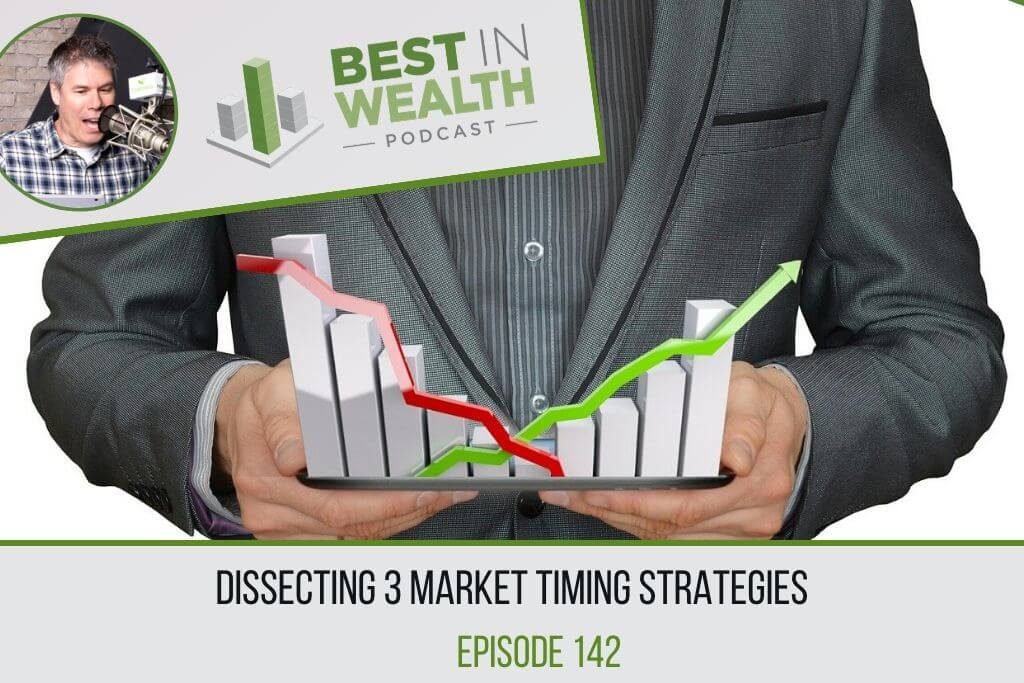Dissecting 3 Market Timing Strategies, Ep #142

Is it ever a good time to take your money out of the market? I am sure everyone was tempted to jump ship when they saw the S&P 500 drop to negative 37.4%. Numbers like those can make anyone reconsider their investment strategy. Will we be better off if we step out of the market for a while? In this episode of Best in Wealth, I dissect 3 market timing strategies. I will cover which yields the most favorable results—and land on one strategy that outperforms the rest.
In this episode of Best in Wealth I dissect 3 Market Timing Strategies—and share which gives you the best return. Check it out! #wealth #retirement #investing #PersonalFinance #FinancialPlanning #RetirementPlanning #WealthManagement Click To TweetOutline of This Episode
- [1:12] When people say “I told you so”
- [4:07] Stick to a set of fundamental principles
- [9:59] The two decisions you have to make
- [11:36] Market timing strategy #1
- [14:22] Market timing strategy #2
- [16:31] Market timing strategy #3
- [19:17] The buy and hold strategy
- [21:15] What can we learn from these numbers?
- [23:01] How do we maintain control?
Market Timing Strategy #1
If we owned stock in the market from July of 1926 to December 2019, we would have an annualized rate of return of 9.57%. In the following strategies, we will be comparing the approximate annualized rate of returns to that average.
The first timing strategy involves taking your money out when the market is down 10%. Then, you wait either 100, 200, or 300 days to inject your money back into the market. After each time-frame, this is what the returns look like:
- 100 Days: Annualized rate of return of 7.11%
- 200 Days: Annualized rate of return of 6.67%
- 300 Days: Annualized rate of return of 5.89%
As you can see, these numbers are far below the average of 9.57%. We need a timing strategy that outperforms these numbers.
Market Timing Strategy #2
In this strategy, we hold our money until we hit bear market territory—a 20% drop from the high. If we pulled our money out of the market and reintroduced it at:
- 100 days: 6.8% annualized rate of return
- 200 days: 6.08% annualized rate of return
- 300 days: 5.75% annualized rate of return
This strategy still is not faring any better—let’s move on to the 3rd strategy.
One market timing strategy consists of pulling your investment out of the market when it’s down 20%. Listen to this episode of Best in Wealth for a full explanation! #wealth #retirement #investing #PersonalFinance #FinancialPlanning… Click To TweetMarket Timing Strategy #3
You’ve waited almost as long as you can bear. The market has dropped 30% and everyone feels the need to bail. We want to get to safety and wait for better times. So what happens if you yank your money at this point?
- 100 days: 8.71% annualized rate of return
- 200 days: 8.55% annualized rate of return
- 300 days: 8.66% annualized rate of return
Alright, so this is by far the best strategy. It has a decent rate of return—but still over a percent away from that 9.57% average that we want to be hitting. So what do you do?
The BEST strategy: Buy and Hold
As much as it pains you to think about it, the buy and hold strategy is your best bet. In fact, leaving your money in the market will add up to hundreds of thousands of dollars throughout your lifetime of investing. Granted, these are all hypothetical numbers based on looking at the indexes, but the concept holds true.
Financial downturns are unpleasant for everyone, but investors are trained to reduce an exasperating circumstance by adhering to our core principles. A famous quote of unknown origin goes: “You don’t rise to the occasion, you sink to the level of your training.” That is why we diversify your assets, consistently allocate them, and move towards higher expected returns. We stay away from market timing and stock picking because it undermines your ability to achieve your investment goals.
What is THE BEST strategy to get you the highest % annualized return this year? Listen to this episode of Best in Wealth to find out! #wealth #retirement #investing #PersonalFinance #FinancialPlanning #RetirementPlanning #WealthManagement Click To TweetHow to Maintain Control in a Time of Uncertainty
I have found that the best way to maintain control of your emotions is to practice gratitude. Maintain a positive attitude and hope for a better future. Below I have linked an inspiring Ted Talk by Shawn Anchor about how an attitude of gratitude changes you biologically. Be sure to give it a listen.
In the rest of the episode, I deep-dive into the reasons WHY the ‘buy and hold’ strategy is the way to go. Listen to the whole episode to help minimize some of the fear you have been experiencing.
Resources & People Mentioned
- Best in Wealth Episode 133
- Dimensional Article
- The Happiness Advantage by Shawn Anchor
- Attitude of Gratitude Article
Connect With Scott Wellens
- Schedule a discovery call with Scott
- Send a message to Scott
- Visit Fortress Planning Group
- Connect with Scott on LinkedIn
- Follow Scott on Twitter
- Fortress Planning Group on Facebook
Audio Production and Show notes by
PODCAST FAST TRACK
https://www.podcastfasttrack.com
Podcast Disclaimer:
The Best In Wealth Podcast is hosted by Scott Wellens. Scott Wellens is the principal at Fortress Planning Group. Fortress Planning Group is a registered investment advisory firm regulated by the Securities Act of Wisconsin in accordance and compliance with securities laws and regulations. Fortress Planning Group does not render or offer to render personalized investment or tax advice through the Best In Wealth Podcast. The information provided is for informational purposes only and does not constitute financial, tax, investment or legal advice.



